Russian-Turkish war 1735 — 1739 State of the Russian army
Position in Russia
During the reign of Peter I, Russia fought two times with Turkey. The fight went on with varying success. During the Azov campaigns, Russia was able to get the Azov and begin building a military flotilla in the Black Sea. However, this success was crossed out by the Prut campaign of 1711. Russia returned Azov to Turkey, liquidated the fortresses in the south, and the flotilla was destroyed. During the reign of Catherine I and Peter II, relations with Turkey were peaceful. Russia was preoccupied with domestic problems.
The accession to the throne in 1730 of the Duchess of Courland, the niece of Peter the Great Anna Ioannovna, was the result of a fierce struggle for power. Anna, with the support of the guard, who expressed the interests of the main part of the nobility, rejected the restrictions imposed by the supreme. The Supreme Privy Council was dissolved. Anna Ivanovna began her reign with the punishment of her real and imaginary opponents. At first she acted very carefully. The father of the failed Tsarina, A. G. Golitsyn, was ordered to live permanently on the estate, and other prominent members of the family were sent by the governors to the outskirts of the empire. Prince Dmitry Mikhailovich Golitsyn and his brother Field Marshal Mikhail Mikhailovich Golitsyn retained their high ranks and titles for some time. However, repression soon began. Rod Golitsyn was crushed. A. G. Golitsyn and his family were exiled to Solovki, and his son Ivan, the friend of the late emperor, to Berezov. Field Marshal M. Golitsyn, exhausted by anxieties for his fate, died of a heart attack. At the end of 1731, another field marshal, V. V. Dolgoruky, was imprisoned in the Shlisselburg fortress, although at one time he protested against the attempt to enthrone Catherine Dolgoruky. In 1736, Mr. D. M. Golitsyn was accused of abuse of office, bribery, and “saying godless words.” Dmitry Golitsyn was sent to Shlisselburg, where he died in 1737. Two years later, a new investigation began in the case of Dolgoruky, in which Prince Ivan Alekseevich was subjected to agonizing execution "through the wheel" in Novgorod, and Vasily Lukich, Sergey and Ivan Grigorievich Dolgoruky cut off the head.
Having destroyed the Supreme Privy Council, Anna Ivanovna created in October 1731 the Cabinet of Ministers, similar to the Council for Functions, but even narrower in composition. Initially, it included three dignitaries: A. I. Osterman, Prince A. M. Cherkassky and Count G. I. Golovkin. In 1735, after the death of Golovkin, P. I. Yaguzhinsky was elected a member of the cabinet, and still later, in 1738, A. P. Volynsky. In fact, the Cabinet was headed by Osterman. He made a dizzying career in Russia, starting his service in 1708 as a translator in the Ambassadorial Order. An energetic diplomat, Osterman proved himself as a cunning and even treacherous courtier. Under Catherine I, he showed his loyalty to Menshikov in every way, under Peter II he actively promoted the fall of the former favorite and the elevation of Dolgorukikh, and under Anna Ioannovna he pursued Dolgorukiy themselves. He was also distinguished by the fact that he never patronized any of his friends and was not greedy, did not make great wealth, although he could.
In addition, Field Marshal BK Minnich held leading positions in the empire and in 1730 occupied the post of President of the Military Collegium and favorite of the Empress E. I. Biron. The head of the armed forces of the Russian Empire, Burchard Kristof von Munnich, began his service with Peter the Great in 1721. Tsar Peter I ordered Minikh to draw up a new plan for the fortifications of Kronstadt, then sent him to inspect the Riga fortress and was pleased with the work done. In 1722-1725 Munnich took part in the construction of the Ladoga Canal. His perseverance and sense of duty very much liked the sovereign. At one of the construction visits, Tsar Peter even declared: “He will soon lead the Ladoga Canal to its end; of all the foreigners who were in my service, he knows best how to undertake and produce great things. ” Prussian envoy Axel von Mardefeldt remarked once about Minich that he "comprehended the spirit of Petrov." Indeed, like the emperor, this general did not just try to reach the goal he set, but walked toward it unswervingly, without sparing himself or others.
Despite the very strained relations with Menshikov, Minich managed to avoid disgraces under Catherine I. Under Peter II, Minich rose. The tsar granted Minikh the count's dignity and appointed him to the post of governor-general of St. Petersburg, Ingermanlandia and Karelia. Like Osterman, Minich showed caution and flexibility. During the preparation of the supreme standards, he took a wait-and-see attitude, and after the apparent failure of their plans, he took the side of Anna Ioannovna. Opala Field Marshal M. M. Golitsyn and V. V. Dolgoruky cleared his way to the highest military posts and ranks. The Empress Anna Ioannovna appointed Minikh as president of the Military Collegium and general-field officer (chief of all artillery), and gave him the rank of field-marshal. In 1734, during the War of the Polish Succession, Munnich took Danzig.
Historian D.M. Bantysh-Kamensky gave Munnich the following description: “The Count of Munnich was tall and majestic. Eyes and all facial features showed the wit, fearlessness and firmness of character; voice and posture showed him a hero. He involuntarily instilled in others respect and fear; was extremely hardworking and adventurous; did not know tiredness, slept little, loved order, was distinguished when he wanted courtesy in societies, stood in line with the first engineers and commanders of his time; but together he was proud, ambitious, cunning, exacting and cruel; for his glory, he did not value the blood of the soldiers entrusted to him; seemed like a friend to everyone, not loving anyone. ”
The favorite of Empress Anna Ioannovna Ernst Johann Biron was officially in court service (he was the chief chamberlain), but at the same time he had a strong influence on all public affairs. He was a man of low birth, but he could become a junker chamber at the court of Anna Ioannovna. Soon the clever kurlandets turned into Anna's lover. Shortly after the accession of Anna Ioannovna to the throne, Biron was established in the nobility, and then elevated to the count dignity of the Holy Roman Empire. In 1737, he received the title of Duke of Courland and Semigalsky. No special qualities Biron was no different. At the same time, he was able to maintain his position and ruthlessly dealt with opponents. In addition to suspicion, Biron was notable for his great vanity, embarrassment, embezzlement, and repeatedly participated in various dark machinations. One of the accomplices of Biron was the chief marshal Karl Reinhold Levenvolde, who also enjoyed Osterman's patronage.
Lieutenant-General (field-marshal General-General) Petr Petrovich Lassi, of Irish origin, also belonged to the military elite itself (since 1736 was General Field Marshal). He entered the Russian service back in 1700, participated in the wars of Peter the Great. According to D.M. Bantysh-Kamensky, Lassi “combined with an enlightened mind a kind heart, sublime feelings ... was decisive in military enterprises, wary in peacetime; did not know the court intrigue ... ". Without interfering in court affairs, Lassie was often pushed aside from the solution of important state issues and rarely went beyond the boundaries of his professional activities.
Thus, at the head of Russia in the years of the war with Turkey, there were both outright parasites, temporary workers like Biron and Leuvenvolde, and talented diplomats and military people like Ostermann, Minich and Lassi. They did not possess high spirituality, but they knew their work and inextricably linked their fate with the fate of Russia. Empress Anna did not shine with special state talents.
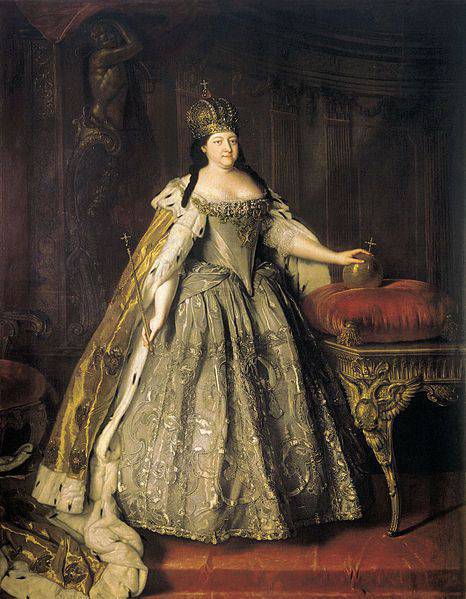
The Empress Anna Ioannovna
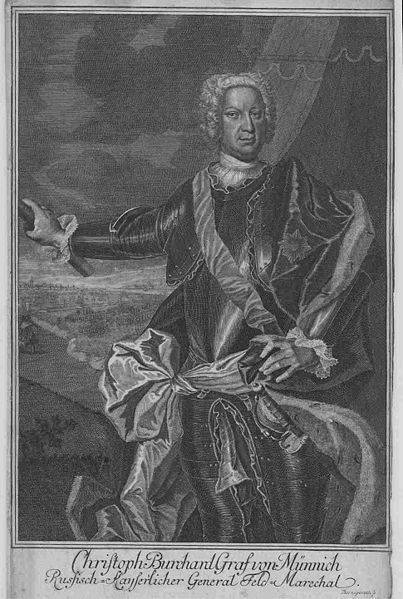
Field Marshal Burhard Christoph von Munnich
State of the armed forces
Immediately after the coming to power of the new empress and her entourage had to solve complex problems relating to the armed forces of the Russian Empire. During the reign of Catherine and Peter II, they fell into disrepair. During his short reign, Peter II had little interest in the army and navy, he was engaged only in hunting. After the resignation of A. Menshikov in 1727, Peter II did not even bother to appoint a new president of the Military Collegium. Large sailing ships were not built with him at all, but only rowing ships were built. In April 1728 at the meeting of the Supreme Privy Council, the emperor ordered that only four frigates and two flutes constantly go out to sea from the entire Russian fleet, and even five frigates were ready for cruising. Other ships, to "save the treasury" had to stay in the ports. On the arguments of the sailors about the need to constantly keep the fleet at sea, the king replied: “When the need calls for the use of ships, then I will go to sea; but I do not intend to walk on it like a grandfather. "
In June, 1730, Empress Anna Ivanovna, ordered the establishment of a special Military Commission, the purpose of which was to restore order in the army. The commission was headed by Munnich. The basis of the Russian army to the beginning of the reign of Anna Ivanovna was regular infantry. It included two guards regiments (Preobrazhensky and Semenovsky), forty army regiments and seventeen regiments of a separate Lower Corps, created in case of a war with Persia. One of the first measures was the creation in 1730, in Moscow, of a new Guards regiment, called Izmailovsky (named after the settlement near Izmailovo, in which the empress lived). Anna Ivanovna and her favorites were suspicious of the “old” Preobrazhensky and Semenovsky guards regiments, in which representatives of the most noble families of the Russian nobility served, and who distinguished themselves in palace coups. The new Guards was recruited from odnodvortsy (descendants of service people who lived on the borders of the country, "ukraintsev-Ukrainians"), not associated with the aristocracy. Adjunct General Leuvenvolde became a colonel and chief of the Izmailovtsy, and Jacob Keith, a Scotsman by birth, became his assistant. In 1731, the regiment was transferred to Petersburg.
In 1731, two army regiments disbanded. In 1733, in connection with the signing of the union treaty with Persia, the regiments of the Ground Corps were returned to Russia and joined the army, with five regiments disbanded. As a result, by the beginning of the war with Porto, the Russian infantry had three guards and fifty army regiments.
According to the states developed by the Military Commission, in peacetime, an army regiment had to consist of 1406 people: 38 officers, 68 non-commissioned officers (sergeants, corporals, etc.), 1152 privates and 148 non-combatant soldiers. In wartime, the number of regiments increased to 1556 people. Each army regiment was divided into two battalions, and each battalion into four companies. Guards regiments were more numerous than the army. The Preobrazhensky regiment consisted of four battalions, and the Semenovsky and Izmailovsky regiments - three battalions each. Marines were called fusilier. They were armed with flintjacks (fuzeas) and swords. In 1731, a new type of fusil was adopted for them. She, like the old one, adopted by Peter I, had a caliber of 19,8 mm, but differed somewhat longer (147 centimeters instead of 142) and a large weight (5,7 kg instead of 5,5). The aimed shooting range did not exceed three hundred steps. Each private soldier had twenty bullets with him, which he carried in two ammunition bags. Thirty more bullets per person were supposed to be transported in boxes on special wagons. For melee rifles were equipped with a triangular bayonet length 44,5, see. In 1737, the fuzees decided to shorten again. In addition, the barrel was attached to the box not with iron pins, like those of the 1715 and 1731 specimens, but with the help of locking rings, which made the production of weapons and cheapened it. However, it was not possible to supply all the army regiments with uniform weapons in the reign of Anna Ioannovna, and often even in the same regiment there were fuseas that differed from each other.
In addition to the Fusilier infantry, the grenadiers included soldiers armed with hand grenades in addition to fuzes. During the reign of Peter I, special grenadier regiments were created, but in 1731, at the initiative of Minich, they were disbanded, and the grenadiers were distributed among the infantry regiments at the rate of ten people per company. Since the grenades at that time were quite heavy (2,5 kg), the strongest and tallest soldiers were selected for grenadiers.
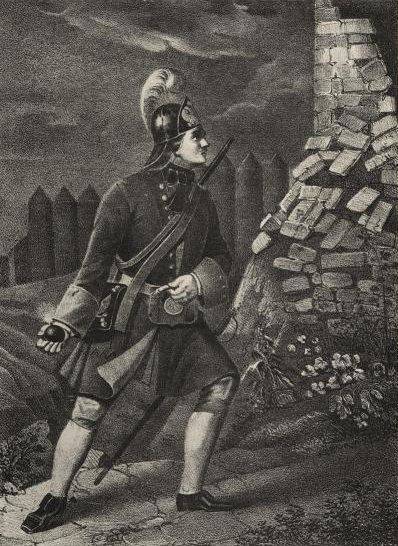
Private grenadier of the Preobrazhensky regiment with 1700 to 1732 year
Sergeants of infantry regiments were armed with halberds - small hatchets on long shafts. Non-combatant soldiers, instead of swords, wore Prussian-style half-sabers. Officers were supposed to have swords and spans. Espanton is a short spear with a flat and wide tip and was a ceremonial rather than a combat weapon. In 1736, Mr. Munnich ordered that the officers would not take the Espantons to march “for they do not recognize the need for them against the current enemy”. Instead of useless spears, the officers received short rifles with bayonets. On the initiative of Minikh, to fight the Tatar cavalry, infantry regiments began to be equipped with pikener and suretochnye spears. The first armed, with the deployed build, the soldiers of the second rank. The second, heavier ones, were fixed in special bars and turned into a kind of anti-cavalier hedgehogs. In each regiment going on the march, there should have been 288 picketer copies, 1200 sutural copies and 48 bars.
A clearly unfortunate innovation was the introduction in 1730 of the years for soldiers of powdered hairstyles with braids. These hairstyles took a lot of time from warriors and turned out to be very unhygienic, especially since in some shelves, in the absence of powder, they used flour mixed with kvass.
The cavalry underwent a serious reorganization. By 1730, the regular cavalry consisted only of dragoons, who numbered the 33 regiment. The dragoons were a kind of “riding infantry” and were trained in combat, both on foot and in horse formation. However, the dragoons, although they could serve as infantry, were not full-fledged cavalry. Minich made new states for the army, replacing the old “sheet” of 1704, introduced into the army the corps of heavy cavalry (cuirassier). Cuirassiers were to become the shock force of the Russian cavalry. They were supplied with armor that protected the chest (cuirass), received the best horses and underwent intensive training. Cuirassiers had to withstand the blow of the enemy's heavy cavalry and act against the Turkish troops. Unfortunately, due to financial difficulties, by the start of the war with the Turks they had managed to create only three cuirassier regiments.
In addition, at the beginning of 1731, Empress Anna Ioannovna issued a decree saying: "Former Life Regiment call the Horse Guards, and to be in rank against Guards, and be in the regiment of non-commissioned officers and ordinary thousand people." This is how the Life Guards Horse Regiment, one of the most privileged in the Russian army, appeared. The Tsarina herself conferred the rank of colonel of this regiment, and appointed Yaguzhinsky a lieutenant colonel. Thus, after all re-formations, the Russian cavalry included one Guards, 3 Cuirassiers and 29 dragoon regiments numbering almost 36 thousand people.
According to the 1731 state, the number of one dragoon regiment was 1093 people in peacetime and 1225 people in wartime. The number of cuirassiers of the regiment did not change, always equaling the 974 man. Each dragoon or cuirassier regiment was divided into ten companies. The dragoons were armed with rifles with bayonets, broadswords and pistols. For cuirassiers, instead of fuzes, it was prescribed to have shortened carbines, and their broadswords were noticeably longer and heavier than the dragoons.
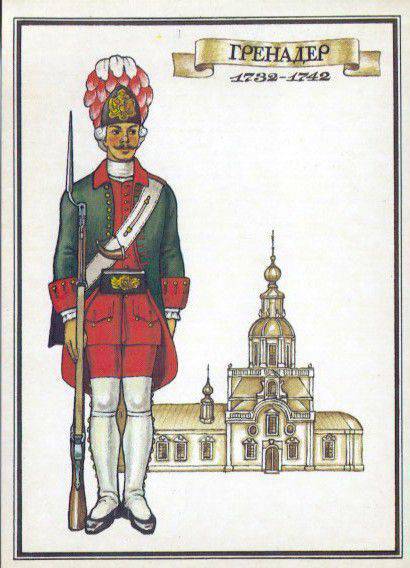
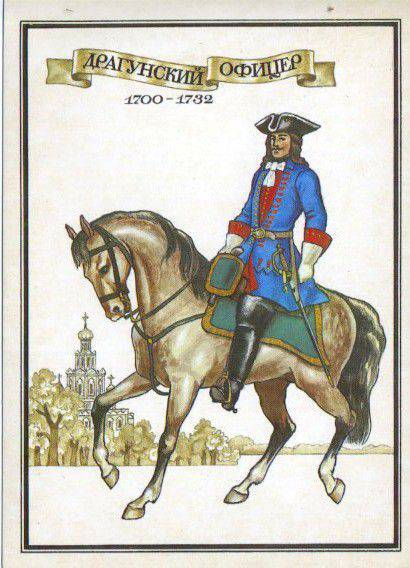
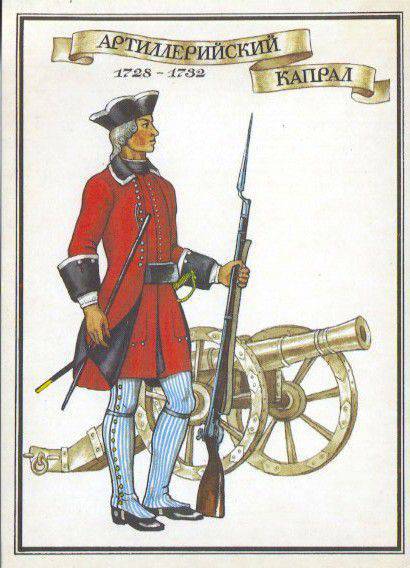
Artillery in the time of Anna Ivanovna was divided into field, siege and serfs. In each infantry army regiment, according to the states of 1731, it was necessary to have two cannons, which would hit three pounds (1,2 kg) in nuclei. The dragoons only had one cannon per regiment, but not all the regiments had them. There was also a separate Artillery regiment of 1046 officers and lower ranks. As a separate unit, he did not act, but in the field conditions, brigades of arbitrary size were formed from his ten companies, which, depending on the situation, were assigned to the troops. The Artillery Regiment, according to the states of 1731, was attributed to 63 guns. The field artillery was armed with three, six, eight, and twelve pounds of cannon, pontoon and half-howitz howitzers, as well as mortars, special artillery pieces intended for hanging fire. Three-pound cannons were the most used and accounted for up to a quarter of artillery. The guns were fired with nuclei, explosive grenades, [with metal bullets - grapeshot and brand-guns (special incendiary projectiles). For each three-pound gun, for example, it was assumed to have 120 cores, 25 grenades and 30 card charges.
In 1737, Mr. Munnich came to the conclusion that reinforcement of the regimental artillery was necessary in order to strengthen the army’s firepower. At his suggestion, the Empress Anna Ioannovna adopted a personal decree, which prescribed four three-pounder cannons for each infantry regiment, and two for each dragoon regiment. As a result, the firepower of the field artillery doubled, which was of great benefit in the battles with the Ottomans and the Crimean Tatars. The increase in artillery was achieved at the expense of three-pound cannons, the lightest at that time, therefore the mobility of the regiments practically did not decrease.
Siege artillery was divided into three corps. Its base at the time described was mortars, not large-caliber siege cannons, as under Peter I. The fortress artillery was located in garrisons and fortresses and included, along with guns that met the requirements of the time, a large number of obsolete models. The states of siege and serf artillery underwent multiple changes, but none of the options developed by the Commission was ever approved. Its main bases were located in St. Petersburg, Bryansk, Osered.
The Russian army also had an engineer regiment and a mine company. In addition, there were garrison troops intended for internal service. They also consisted of infantry and dragoons. By 1730, the garrison troops consisted of forty-nine regiments and two separate infantry battalions, four regiments and two separate dragoon squadrons. In 1734-1736 three more dragoon regiments were added to them. In addition to the main function, the garrisons were engaged in the initial training of recruits before being sent to the field army.
Along with regular military units in the Russian army included numerous irregular formations. It was based on the Cossacks: Don, Little Russia, Chuguev, Yaik, Slobodsky, etc. The number of registered (ie officially registered by the authorities) Don Cossacks in the reign of Anna Ivanovna was about 15 thousand people. Minikh highly appreciated the Donians and wrote in one of his orders that they "were so faithful and enthusiastic about the service and the fatherland, how it is impossible to demand more." Cossacks most often played the role of light cavalry and military intelligence. Horses, weapons and clothing they acquired at their own expense. Cossack armament consisted of lances, sabers, a gun without a bayonet, but, due to the lack of regularity, was very diverse. The Cossacks ordered rifles and sabers on Russian manufactories, bought from individual artisans, used captured weapons. Going to a campaign, they united in the shelves of different composition.
It is worth noting that the Cossacks still retained some of the internal autonomy. The authorities were especially suspicious of the Little Russian Cossacks (the number of the registered Little Russian Cossacks was about 50 thousand people - an entire army). Even under Peter I, in 1722, the election of hetmans was eliminated, and the management of the entire Left-Bank Ukraine was transferred to the Little Russian Collegium. But, the constant threat of war with the Ottoman Empire forced the government to make concessions to the Cossacks. In 1727, Tsar Peter II abolished the Little Russian Collegium and allowed the election of a hetman, who became Mirgorodsky colonel Danila Apostol. The “Minister” Fedor Naumov was assigned to control the hetman. In January, the Apostle died on 1734 and, by a decision of the Cabinet of Ministers, power was transferred to the Hetman's Board, a collegial body of tsarist officials and Cossack officers. This decision caused strong discontent of the Cossacks, which the foreman tormented. The foreman was a peculiar social group that absorbed the worst qualities of the Polish gentry — exorbitant arrogance, stupidity and greed.
Therefore, during the war with Turkey 1735-1739. Russian commanders regarded Little Russian Cossacks with great suspicion. So Minich in 1739, being passing through Glukhov and learning about the decision of the local court that was unfavorable for him, shouted at the judges: “You need to hang such judges or, with a whip, send them to Siberia!” The Ukrainian field-marshal expressed Ukrainian law with military directness: “ Rogue wrote, and the canal judged. "
The most militarily organized were the Slobodian and Chuguev Cossacks. Suburban Cossacks, both peacefully and during the war, united into five regiments, which constituted a brigade subordinate to the commander of the Ukrainian division. From 1729 to 1731, four out of five Slobodsky regiments were formed from Cossacks one regular company. In 1736, there were two such companies in each regiment, and in 1739, all ten regular Cossack companies were consolidated into the Sloboda Regiment. The Chuguev Cossacks were united into one regiment of the five hundred members, three hundred of which were actually Cossacks, and two hundred were baptized Kalmyks. In 1734, the Zaporozhye Cossacks settled in the New Sich at the mouth of the Buzuvluk River were again taken into Russian citizenship. The great experience of the struggle against the Ottomans made them very valuable for the Russian army, but the Cossacks, who were used to freemen, were also extremely undisciplined, which irritated the command.
The hussars were also part of the Russian army. Even Tsar Peter I instructed his diplomats to recruit Serbs, Croats, Hungarians, who were settled in Little Russia and provided with salaries "as they received from the Roman Caesar." By 1731, there were about four hundred hussars, mostly Serbs. In 1737, already during the war, Colonel Stoyanov was able to form the Serbian Hussars, and a year later, Colonel Kuming brought two companies of cavalrymen from Hungary, who brought them to the Hungarian Hussars. In 1739, Prince Mamukov-Davydov received permission to form a Georgian hussar company as part of 74 people. All the hussars, on former grounds, receiving salaries from the government and plots of land in the border areas, had to support themselves.
In 1731, Minich proposed to defend Little Russia from Tatar raids to arrange "between the Seversky Donets and Berestovaya and Orel rivers and along the Seversky Donets line, and see where the dangerous places to the enemy passage, make a fortress." The defense of this line was entrusted to the landmilitia, the reorganization of which was assigned to colonels Tarakanov and Debrigny. As a result of their activities, twenty Landmilitsa regiments were created, of which nine (four infantry and five cavalry) settled on the line, and the rest were collected only in wartime. The militiamen lived in their houses and had a household, but at the same time they constantly (and not periodically, like most Cossacks) served. In the summer, they were collected for training in special camps.
In addition, the Kalmyk detachments, led by their foremen, were part of the Russian army. They were armed with bows, sabers, spears and other weapons.
To be continued ...
Information